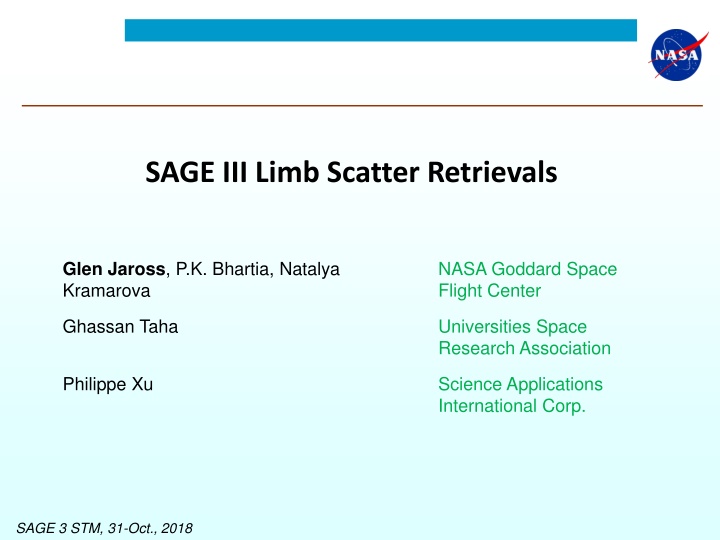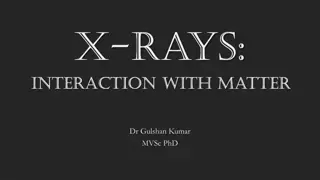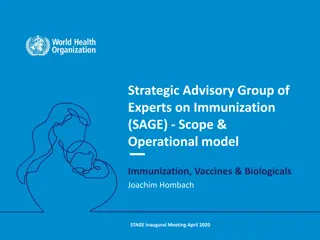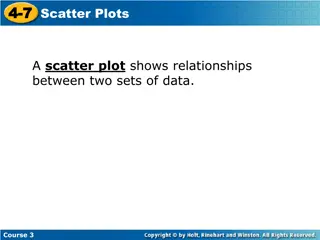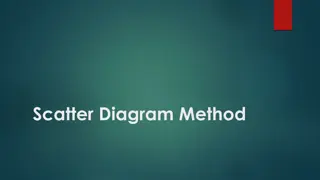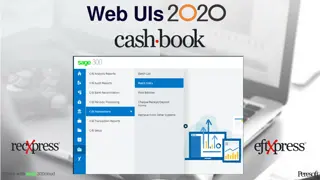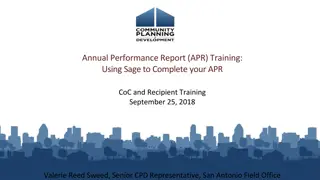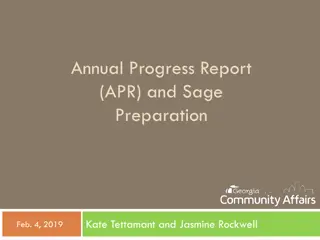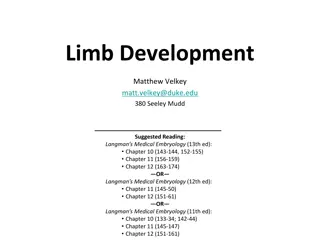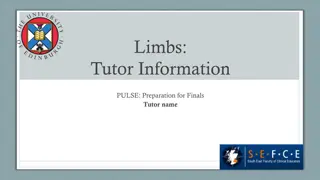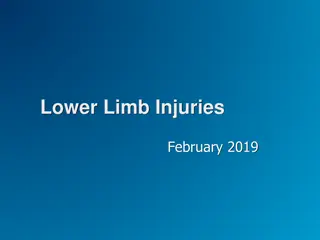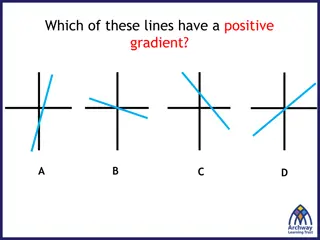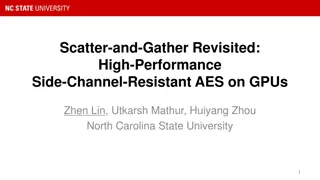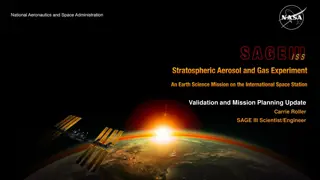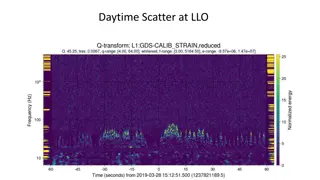Advanced Analysis of SAGE III Limb Scatter Retrievals
The proposed effort focuses on enhancing LaRC operational retrieval codes for SAGE LS data, correcting Level 1 radiances, and recommending LS operational scenarios. OMPS LS retrieval algorithms for aerosol and ozone, as well as the SAGE/M3 LS ozone retrieval approach, are detailed. Out-of-field stray light issues and diagnostics from RTM radiance residuals are discussed to improve data accuracy.
Download Presentation

Please find below an Image/Link to download the presentation.
The content on the website is provided AS IS for your information and personal use only. It may not be sold, licensed, or shared on other websites without obtaining consent from the author.If you encounter any issues during the download, it is possible that the publisher has removed the file from their server.
You are allowed to download the files provided on this website for personal or commercial use, subject to the condition that they are used lawfully. All files are the property of their respective owners.
The content on the website is provided AS IS for your information and personal use only. It may not be sold, licensed, or shared on other websites without obtaining consent from the author.
E N D
Presentation Transcript
SAGE III Limb Scatter Retrievals Glen Jaross, P.K. Bhartia, Natalya Kramarova NASA Goddard Space Flight Center Ghassan Taha Universities Space Research Association Philippe Xu Science Applications International Corp. SAGE 3 STM, 31-Oct., 2018
Proposed effort 1. Provide LaRC operational retrieval codes that will work for SAGE LS data Ozone and aerosol extinction Based on existing OMPS retrievals 2. Correct Level 1 radiances for problems affecting product accuracy Stray Light: out-of-band and out-of-field Tangent Height registration errors We assume the Level 1 SAGE LS product will have only basic TH registration and no SL correction 3. Recommend LS operations scenarios
OMPS LS retrieval algorithms Aerosol v1.5 algorithm Ozone v2.5 algorithm Computes extinction profile at 675 nm; 3 UV pairs and 1 VIS triplet; Radiances are normalized at 45 km; Radiances are normalized at 55 km for UV and 40 km for VIS ranges (no retrievals above); Gamma size distribution in Mie calculation; Include the explicit aerosol correction by using LP-derived aerosols; Chahine s non-linear relaxation algorithm; Cut off at cloud top; Algorithm uses realistic a priori covariance matrices instead of Tikhanov regularization; Residuals calculated at 8 wavelengths. Limited wavelengths allow us to better isolate instrumental issues
SAGE/M3 LS retrievals Ozone retrieval approach is mostly unchanged from previous SAGE III LS retrievals
Out-of-Field stray light M3-SAGE LS Signal M3-SAGE LS Signal Telescope scatters bright Earth signal into higher altitude angles (in-band) We will apply the same SL removal technique as used on M3 SAGE LS and GOMOS LS Excess signal at retrieval normalization altitude Primarily a VIS/NIR problem
Diagnostics from RTM radiance residuals OMPS residuals Stray Light Rayleigh residual=(Im-I0)/I0 where Im is the measured radiances and I0 is the calculated radiance for a Rayleigh atmosphere only. All radiances are normalized at 40.5km to reduce effects of surface/cloud reflectance and sensor absolute calibration. OOF stray light is inherently worse at longer wavelengths due to signal reduction with altitude
Out-of-Band stray light OMPS Res40km Res55km Without Correction With Correction Primarily a UV problem Pair Wavelength Retrieval Wavelengths SAGE has more out- of-band SL than OMPS (grating vs. prism) SL error need not be zero, just spectrally flat
Instrumental and RTM issues OMPS radiance residuals from LS RTM (aerosol extinction from OMPS) UV to VIS retrieval transition Aerosol extinction and/or stray light OMPS O3 Calibration ? Cloud SAGE- OMPS O3 difference SAGE O3
Two tangent height verification methods where d is a radiance residual ?(?,? = ?? ???? ?(?,? ? ?,? ? = (?,? (?,? - ?? ???? Calculated sensitivity Calculated sensitivity ARRM RSAS 65 65 (a) (b) ? 350nm,? ? 305nm,? 60 60 Use of ? < 310 nm at z = 65 km minimizes DUR error 55 55 Susceptible to non-Rayleigh errors: aerosols Altitude (km) Altitude (km) 50 50 45 45 Also sensitive to stray light errors 40 40 35 35 0 1 2 I(z) (mW/m 3 4 5 6 -20 -15 -10 d(lnI) / dz (%/km) -5 0 5 10 2-sr) OMPS
Convert SAGE Level 1B to OMPS-like L1 Radiances from each scan on a common time stamp Solar angles calculated at 35 km Radiances interpolated or smoothed to uniform 1 km grid and OMPS wavelengths/bandpass (initial version) Additional stray light or tangent height corrections applied as necessary OMPS Level 1B (geolocated, calibrated, irregular spectral/spatial sampling) OMPS Level 1G (geolocated, calibrated, uniform spectral/spatial grid) Level 2 Aerosol 675 nm extinction coefficients Level 2 Ozone Number density vertical profile SAGE Level 1B (geolocated, calibrated, irregular spatial sampling) SAGE Level 1G (geolocated, calibrated, uniform spectral/spatial grid) Existing Code New Code Provided by LaRC
Timeline Phase 1 Convert SAGE L1B to OMPS L1G format (degrade SAGE bandwidth in VIS) Generate basic OMPS O3 and AER675 products Initial software package to LaRC Begin RTM residuals evaluation using MLS, OMPS profiles Phase 2 Introduce empirical calibration corrections in L1G Modified retrievals working at SAGE resolution Continue residuals eval. with SAGE SO profiles Phase 3 Multi-wavelength aerosol extinctions Final software package to LaRC
Summary LS Team will deliver LS retrieval software in 2 stages Team will evaluate and attempt to correct stray light and other errors Work started to make LS retrieval codes instrument agnostic We need: L1B LS product definition / sample products - SAGE LS measurement timeline -
